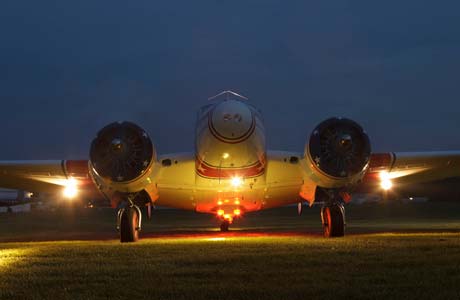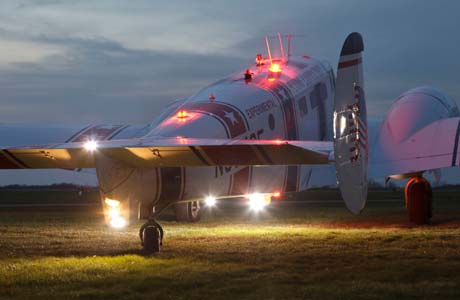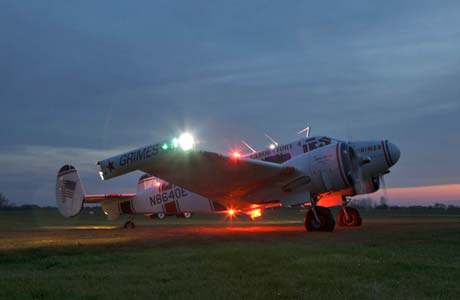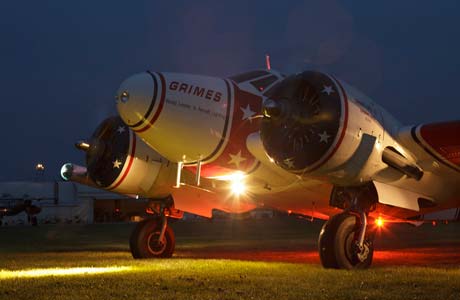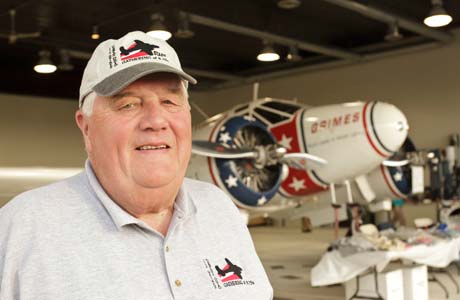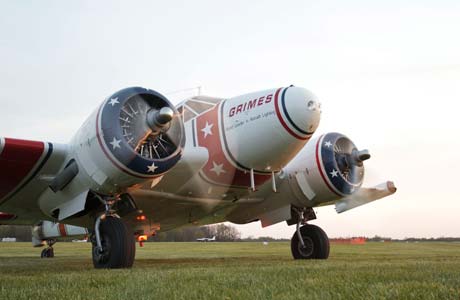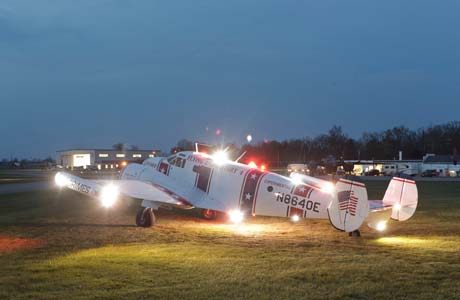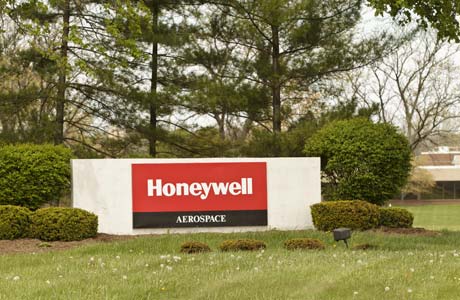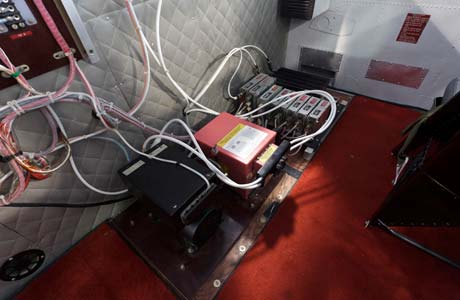It’s big and slow. The familiar green, red, and white navigation lights indicative of an airplane aren’t visible. One bystander on the ground watches the craft fly low in the Ohio night sky, focusing on the oddly positioned white lights for clues. For decades, others across the country have scratched their heads at the same spectacle, some even reporting UFO sightings causing the Air Force to scramble interceptors.
Pilots and residents in Urbana, Ohio, know this UFO well: the Grimes Flying Lab Beech 18 powered by two 450-horsepower Pratt & Whitney 985 engines and outfitted with 56 exterior lights, including incandescent, rotating, strobe, LED, quartz, and halogen. The lab is a piece of flying history, a symbol of pride, passion, and booming business for the community of 11,000.
“The Urbana community is in love with the airplane,” said Jerry Gecowets, president of the Grimes Flying Lab Foundation.
Chris Palmer, a corporate King Air 200 pilot, flies the Beech 18—once a test bed and sales demonstration platform for the Grimes Manufacturing Co.—three times a month during the summer and to special events, including the Urbana High School graduation and Fourth of July celebrations. He’s also flown it to EAA AirVenture and Sun ‘n Fun to show off the heritage of the lighting company to wider audiences. But he’s not the one who lights the Flying Lab like a UFO, with multiple lights on the tail and belly, and lighting pods on the wingtips.
 “I can control the usual lights from the cockpit such as the navigation lights and landing lights,” Palmer explained. “When we operate all of the other lights someone else has to sit in a seat in the back.” A panel of switches in the rear operates “inverters, power supplies, and lights.” Meanwhile, the experienced DC-3 and Twin Beech pilot focuses on flying the aircraft. “Everything is challenging about taxiing and flying an old, heavy multiengine tailwheel airplane,” he said. “You always have to be thinking ahead of it.”
“I can control the usual lights from the cockpit such as the navigation lights and landing lights,” Palmer explained. “When we operate all of the other lights someone else has to sit in a seat in the back.” A panel of switches in the rear operates “inverters, power supplies, and lights.” Meanwhile, the experienced DC-3 and Twin Beech pilot focuses on flying the aircraft. “Everything is challenging about taxiing and flying an old, heavy multiengine tailwheel airplane,” he said. “You always have to be thinking ahead of it.”
Legend behind the aircraft
The Grimes name likely sounds familiar, especially to those who’ve owned and fly older aircraft. Chances are the company manufactured the lights. Warren Grimes created the first aircraft light for a general aviation airplane—Henry Ford’s Tri-motor—and later started the Grimes Manufacturing Co. in 1933, employing thousands from Urbana over the years and having a monopoly on aircraft lighting, including GA, airlines, military, and space. The company was the major manufacturer of aircraft lighting during World War II.
“He was there at the right time with the right product,” Gecowets said of Grimes, who also donated the airport, Grimes Field, to the town.
The company produced lights for the lunar module, Lockheed L-1011, Boeing 727, and more. A biweekly newsletter, the Grimes Times published by employees, notes milestones of the aircraft they supplied with lights. It was intended to keep everyone up to date on the company’s business, but a quick glance through the archives at the Flying Lab’s museum at Grimes Field proves it informed employees of one another’s business as well. Touted as “the official source of information for employees,” it included articles on teamwork, office gossip, and romance on the production line. An issue published during World War II included a yearbook-style insert with pictures of their coworkers and friends who had left the company to fight in the war.
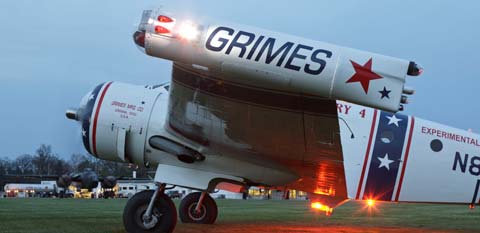
After nearly four decades, the business changed hands several times, eventually dropping most of the GA market. Today, it continues as part of Honeywell at a factory on the south side of town. “Everybody knew somebody who worked there,” said Chris McConnell, a longtime Honeywell Aerospace employee in the engineering lab at Urbana.
A flying test bed
In 1964, the company added special lighting to the Beech 18’s tail, belly, and wingtip pods to turn the aircraft into a test bed. “That’s how they did a lot of research,” said McConnell, who serves as the lighting engineer on the Beech 18. “It would travel all across the country.” The aircraft was painted red, white, and blue in a stars-and-stripes theme in the early 1970s for the country’s bicentennial before going on tour in Europe.
The aircraft continued being used as a test bed, and sales and demonstration platform into the 1980s when Gecowets gained some time in the right seat, a nice gesture from the aircraft’s pilots for the general manager of the light products group. That’s when he first fell in love with the aircraft that would weather highs and lows and demand much of Gecowets’ time and energy.
Labor of love
“There’s not another airplane that exists that’s like this airplane,” Gecowets said. The aircraft suffered damage in the 1980s, when the company’s corporate pilots made a low pass over an airport and ripped off skin under one of the Beech 18’s wings on an obstruction. The Flying Lab made it back to Urbana, but sat grounded until it was sold to operators at Red Stewart Airfield in Waynesville, Ohio, just 50 miles to the south. It sat derelict for 13 years, according to a historical account in Warbird Digest. Employees and pilots who regularly drove by the aircraft, watching its condition deteriorate, talked about ways to bring the aircraft back to Urbana, Gecowets said.
Honeywell Aerospace, the latest to acquire the aircraft lighting company, repurchased the airplane in 1999 when it took over the company and began the restoration effort.

“I was there the day they pulled the airplane out of the weeds at Red Stewart Airfield in Waynesville,” said Palmer, who couldn’t help with the restoration but followed the progress. The passionate group moved the Beech 18 on a trailer during a cold winter day that began a 10-year restoration effort. When the process proved too expensive for Honeywell, Gecowets and others involved in the effort formed the Grimes Flying Lab Foundation.
“I can’t believe I get to fly an airplane that means so much to so many people,” Palmer said, noting the pride he sees on each restorer’s face as he taxis or flies the airplane. “It took a lot of dedication, skill, and hard work to restore the airplane. I take it very seriously that they trust me to fly this wonderful piece of history.”
He should take is seriously; he’s lucky members of the foundation even share it. “It’s like having another wife,” said Gecowets. “My wife will vouch for that!”

